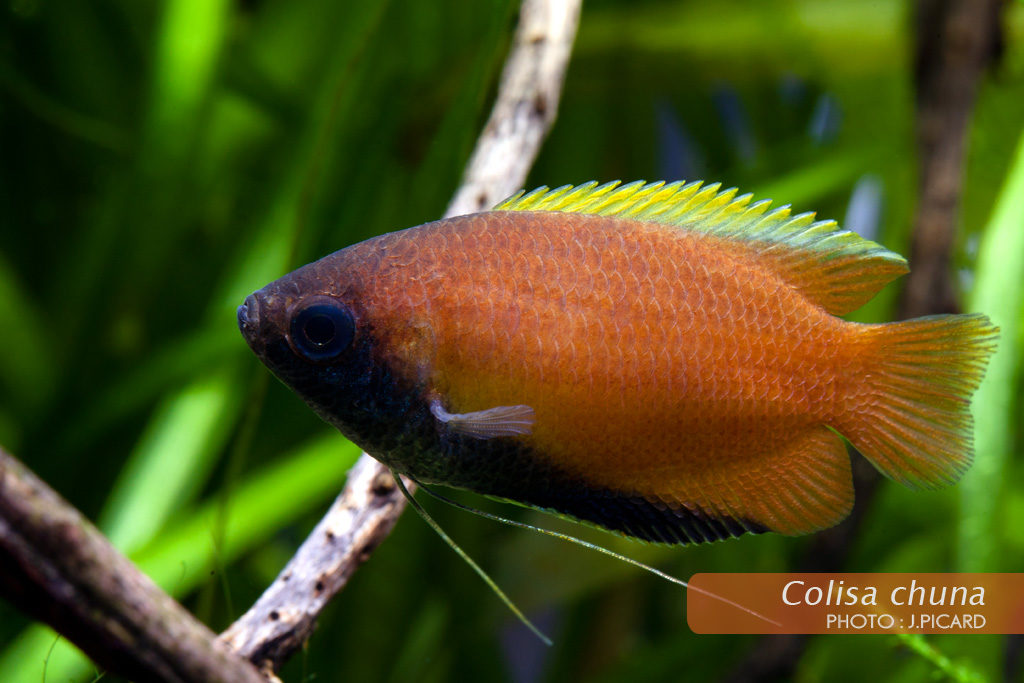honey gourami the group Trichogaster chuna or the Honey gourami Colisa Chuna in the imagination: Today we want to give you a special representative of the great group of gourami introduce. The honey gourami is certainly very popular with many aquarists. In this profile of the honey gourami, we will take a closer look at keeping, breeding, appearance and origin. As always, there are also the most important requirements for the water and the aquarium.

Origin and distribution of the honey gourami
Honey gourami is mainly found in India. Or rather, in the north-eastern part of India. There the honey gourami will be found in the wild, especially in the Brahmaputra and also in the Ganges area. Most of the wild catches and imports come from Bangladesh.
There they live in rather muddy waters. These also have little current, which should also be considered in the aquarium. The orange or golden honey gourami counts here. But Colisa Chuna is also the Latin name there.
Honey gourami or threadfish have a special feature. You also belong to the group of labyrinth. They have a special organ that allows them to breathe air from the surface. That's why you often see the honey gourami or gourami in general gasping for air on the surface.
Characteristics and appearance of the honey gourami
Now let's get to the looks. There are significant differences between the wild forms and the bred ones. In specialist shops you can now get the honey gourami in gold, orange or red. The wild form, or one might say the original form, has a black stripe or markings from the fish's mouth to the caudal fin. This is not always black or brown, but can sometimes fade depending on the mood. In addition, a different coloring of the fish is possible during courtship. Anyone who has already kept the honey gourami with them will have already noticed this change in color. The honey gourami can also take on other colors when forming territories or caring for the brood.
The orange color is also responsible for the naming "honey".
As with most fish, the females also get a little larger here. The honey gourami is the smallest representative of the threadfish. It grows to around 5 cm and is therefore even smaller than the dwarf gouramis.
Another distinguishing feature of whether it is a female or a male is usually the much more intense colouring. In addition, this becomes even more intense during courtship.
The honey gouramis live up to 5 years on average. Perhaps a word about socialization. The animals are extremely peaceful but territorial, so no other threadfish should be used. With the other species such as tetras or barbel, a lot is possible. However, fin eaters and pluckers should not be used.
Husbandry and water parameters of the honey gourami
Let's first set up the aquarium, because the honey gourami also needs a very quiet area in the aquarium. Like the gourami, it builds foam nests, for which it in turn needs very densely planted tanks. Floating plants are also predestined for this. But also in the middle water area you should create good retreat possibilities for the honey gourami.
Let's get to the aquarium size. Here you can read 60m liters in the literature again and again and we would agree with that. From an edge length of 60 cm, honey gourami seem to feel comfortable. However, honey gourami should only be kept in pairs and several pairs only seem possible in very large aquariums.
For the water values, you should set the temperature to around 22 – 28 degrees. The PH value should be between 6 and 7,5. When it comes to the hardness of the water, you seem to be doing very well in the range of up to 15, although soft water is also better suited here.
As already mentioned, the planting is important.
One more thing about feeding the animals. You can give live food on the one hand and flake food on the other. As always, you should be prepared for high-quality feed. Frozen food can also be given. can do this Artemia or else mosquito larvae be used. As always, here are the most important things in brief.
- Temperature of 22 – 28 degrees
- PH value from 6 to 7,5
- Hardness up to 15 degrees
- quiet areas
- Good planting
- Keeping in pairs only
- floating plants
- Dry food, live food, frozen food
Breeding of honey gourami
Let's come to the breeding of the animals, because this is basically the same as with the threadfish. The animals build a foam nest in which the spawn is then laid. After about 2 to 3 days the young hatch, which can be fed with Artemia.
However, in order to bring the animals to spawn, you should prepare the tank accordingly. In a community tank, this will give very little chance of success. However, if you take a breeding tank with acidic and soft water and a very low water level, the male will build the foam nest very quickly. The up to 500 eggs climb up (the reason for this is an oil film on the eggs) and get stuck in the foam nest. After 2-3 days, when the young have hatched, the parents should be removed, otherwise they could attack the young. Now it's time to feed with rearing and dust food as well as Artemia.



